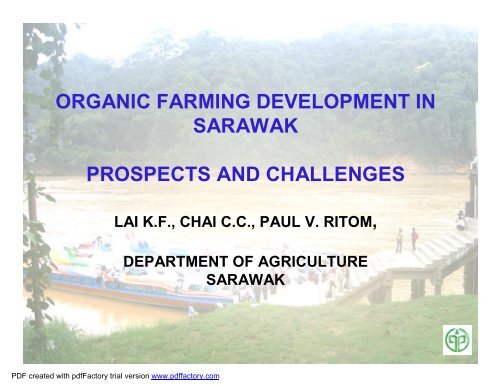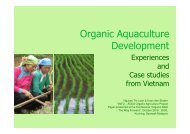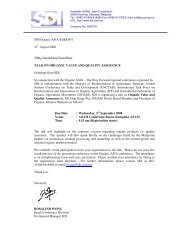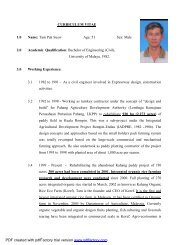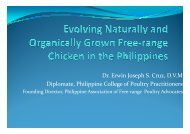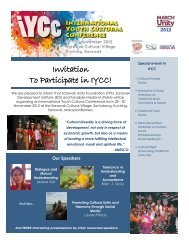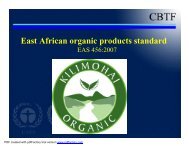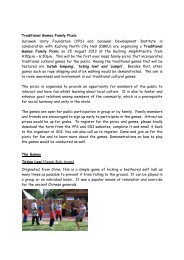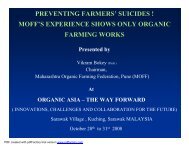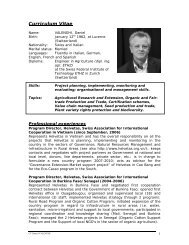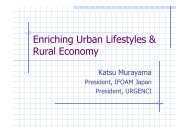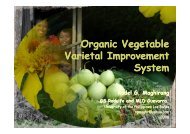LAI KUI FONG - Sarawak Development Institute
LAI KUI FONG - Sarawak Development Institute
LAI KUI FONG - Sarawak Development Institute
Create successful ePaper yourself
Turn your PDF publications into a flip-book with our unique Google optimized e-Paper software.
ORGANIC FARMING DEVELOPMENT INSARAWAKPROSPECTS AND CHALLENGES<strong>LAI</strong> K.F., CHAI C.C., PAUL V. RITOM,DEPARTMENT OF AGRICULTURESARAWAKPDF created with pdfFactory trial version www.pdffactory.com
Part IAGRICULTURAL DEVELOPMENT INSARAWAKPre Malaysia to Present Days ……..PDF created with pdfFactory trial version www.pdffactory.com
Pre Malaysia period….INTRODUCTION‣ Farming – by & large traditional in nature‣ ‘Export crop’ oriented & subsistence agriculture‣ Main export crops are pepper and rubber‣ Subsistence agriculture with main goal to feed thefamily : food crops including hill & wet rice,vegetables, field crops & fruitsContinued ……PDF created with pdfFactory trial version www.pdffactory.com
INTRODUCTIONSince formation of Malaysia – rapid agriculturaldevelopment1960s to 1980s (1 st to 4 th Malaysia Plan)‣ Major crops are :• Rubber• Rice• Pepper• Coconut & cocoa• Oil-palm• SagoContinued ……PDF created with pdfFactory trial version www.pdffactory.com
INTRODUCTION1980s to 1990s (5 th to 7 th MP)‣ Decline in coconut, cocoa & rubber‣ Rice somewhat stagnated & pepper fluctuating inconsonance with market‣ But the following commodities expanded :• Oil-palm• Sago• Vegetables• FruitsContinued ……PDF created with pdfFactory trial version www.pdffactory.com
INTRODUCTIONLate 1990s to current times (8 th to 9 th MP)‣ Continued decline in cocoa‣ Commercial development by government-linkedagencies on rubber, oil palm, rice, sago‣ Concurrent development on vegetable, fruit & oilpalm, animal husbandry & aquaculture led by theprivate sectorPDF created with pdfFactory trial version www.pdffactory.com
The need for alternatives toagrochemicals ways of farming‣ Commercial development of cash & food crops byConventional intensive system led to increasingapplication of agrochemicals‣ The improper usage resulted in high residues on cropsproduce & also led to environmental problems:‣ Contamination to waterways & ground water source‣ Endangering & threatening wild life survival‣ Food chain destruction & weakeninge.g. Agrochemical residues in vegetables as in thenext slidePDF created with pdfFactory trial version www.pdffactory.com
Vegetable pesticide residue (% exceed MRL)%20151050199314.9 168.8 9.8 18.34.9199419951996199719982004 to 2008: @
Quality Assurance SchemesRelevant crops certification schemes:‣ VCS : Vegetable Certification Scheme – a DOA<strong>Sarawak</strong>’s initiative, implemented in 1998‣ SALM : Malaysia Farm Certification Scheme – aNational Scheme, DOA Malaysia initiative, since2003 (MSGAP & EUREGAP as benchmarks)‣ DOA <strong>Sarawak</strong> adopted SOM : Malaysia OrganicCertification Scheme in 2005PDF created with pdfFactory trial version www.pdffactory.com
Part II IIORGANIC FARMING IN THE LOCALCONTEXTPDF created with pdfFactory trial version www.pdffactory.com
Organic Farming – in local context :‣ A holistic approach on Supply Chain–From production to marketing‣ Compliance & Certified to OrganicStandards – e.g. MS 1529‣ Old practice with new improvements–(incorporated with modern tech &Quality Assurance)PDF created with pdfFactory trial version www.pdffactory.com
<strong>Sarawak</strong>’s Strength‣ Large tract of land under natural vegetation‣ Relatively free from industrial, urban & industrialpollution‣ Farming still very traditional at large- conversioncould be easier‣ At infancy stage – not easy to teach – but sure togrow up fast & well!Continued ……PDF created with pdfFactory trial version www.pdffactory.com
<strong>Sarawak</strong>’s Strength‣ Large plant germplasm & mega-biodiversity‣ Crop range fits niche & export market – e.g.pepper, indigenous rice, fruit & vegetables‣ Gathered wild products are naturally organic‣ Abundance of vegetation provides sourcebiomass for composting‣ Farmers are responsive to new ideas & technologyPDF created with pdfFactory trial version www.pdffactory.com
Current Scenario1. Government initiative:‣ DOA – Organic Farming incentives• SOM certification program,• R&D with a few private operators‣ DOA research – fairly youngContinued ….PDF created with pdfFactory trial version www.pdffactory.com
Current Scenario2. Private sector initiative:‣ A number of organic farms• Mainly private sector initiated• Several under collaboration with DOA‣ Only 1 certified to SOM• More to go into certification‣ Many certified to foreign standards• Need harmonisation & recognitionPDF created with pdfFactory trial version www.pdffactory.com
DOA Organic FarmingBroad ObjectiveTowards the socially acceptable,environmentally friendly, profitable& sustainable production,processing and marketing of safe &quality organic food.PDF created with pdfFactory trial version www.pdffactory.com
Specific Objectives‣ To encourage as an alternative production system forthe State‣ To develop niche, export & local market producebased on local priority & uniqueness‣ To encourage Quality Assurance through SOM& other certification systems‣ To develop organic industry- farmers, processors& marketers along the Supply Chain‣ To allocate a set % of financial & human resourcesfor a targeted increase of Organic Farms e.g. 10%per yearPDF created with pdfFactory trial version www.pdffactory.com
Strategies‣ Policy identifying Organic Farming as an Alternativeproduction system‣ Establish State-wide service centres for executingprogrammes & projects‣ Encourage & assist current farmers for conversionto organic system‣ Increase magnitude of Organic FarmingPrograms & IncentivesContinued ….PDF created with pdfFactory trial version www.pdffactory.com
Strategies‣ Step up research on organic technologies‣ Set up training centre to train staff & farmers‣ Establish organic seeds & planting materialproduction centre‣ Interact closely with the Organic FarmersAssociationPDF created with pdfFactory trial version www.pdffactory.com
Specific Research Areas‣ Innovative production system‣ Organic approaches to plant health‣ Soil & plant nutrient management‣ Organic seeds & planting materialsPDF created with pdfFactory trial version www.pdffactory.com
Innovative production system‣ Net house & net tunnel systems‣ Adaptable crops/varieties‣ Cropping system & crop mix‣ Plant & animal waste utilization‣ Beneficial microbes application‣ Vertical & horizontal crop integration‣ Aquatic culturePDF created with pdfFactory trial version www.pdffactory.com
Organic approach to plant health‣ IPM‣ Resistant crop/variety‣ Probiotics & compost teas‣ Botanicals & repellents‣ Companion & repellent crops‣ Animal/birds/crop integrationPDF created with pdfFactory trial version www.pdffactory.com
Soil & plant nutrient management‣ Soil conservation & croppingsystem‣ Soil nutrient management in relationto crop removals & inputs‣ Soil nutrient enrichment via manuring,green manure, legumes & microbes‣ Alley & strip croppingPDF created with pdfFactory trial version www.pdffactory.com
Organic seeds & planting materials‣ DOA as source to provide‣ To conserve, produce,distributePDF created with pdfFactory trial version www.pdffactory.com
Current scenario & challenges‣ No. of farms & farmers @ low level‣ Public awareness @ low level‣ Subject matter knowledge @ low level‣ Interest to invest @ low level‣ DOA emphasis @ minor programme‣ Private initiatives & motivations @ few‣ Market & market access @ low key‣ The challenges are to initiate & Fire theOrganic Engine to run @ high levels !PDF created with pdfFactory trial version www.pdffactory.com
Challenges involving changes to‣ Policy matters‣ Farmers & staff training‣ Publication & information disseminations‣ Training facility & resources‣ Public awareness to healthy & alternative foodsource‣ Alternative to current production systems‣ Organising the prospecting farmers & thebusiness people‣ DOA financial & human resources allocationsPDF created with pdfFactory trial version www.pdffactory.com
Constraints anticipated‣ Takes time to activate changes‣ A change to the ways used to‣ Could be expensive to start‣ Requires high labour input‣ Source of input availability : compost‣ Farmers at large not organised‣ Insufficient channels for farmers interaction‣ Expecting government assistancePDF created with pdfFactory trial version www.pdffactory.com
DOA Plan for Organic FarmingShort Term – Fast Track‣ Develop & intensify govt/private sector –interaction, joint venture R&D‣ Disseminate known technology‣ DOA human resource development‣ Organize prospecting farmers for conversion‣ Provide incentives & assistancePDF created with pdfFactory trial version www.pdffactory.com
DOA Plan for Organic FarmingShort Term – Fast Track‣ Set up commercial compost factory atnorth, central & southern regions‣ Encourage private sector participation‣ Publicity & awareness for organic farming‣ Prioritize crops eg pepper, rice & fruits‣ Study Supply chain to establish weak linksfor improvements‣ Set up special organic food marketsPDF created with pdfFactory trial version www.pdffactory.com
Long Term State <strong>Development</strong>‣ Draw up 5-10 year plan for organic farming‣ DOA sets up a unit for organic farming atHQ/Regional levels‣ Establish export & local supply chain‣ QA through SOM & Others‣ Establish R&D stations‣ Intensify short term plan activities‣ Work on flagship product e.g. rice, pepperPDF created with pdfFactory trial version www.pdffactory.com
ProspectsWith due considerations @World scene:‣ World demand growing‣ Health concerns of quality food‣ Standards & certifications‣ Market access & Supply chain‣ Niche & special market‣ Fossil fuel & products rising costs‣ Agro-eco-tourisms‣ Cottage industriesContinued ….PDF created with pdfFactory trial version www.pdffactory.com
ProspectsConsiderations on @local situations:‣ Available large tract of land under naturalvegetation‣ Natural settings of some farm land – clean streams& scenic view etc – potential for resort/tourist typerelated organic farming (include aquaculture)‣ Large crop diversity & range- good for niche &specialty produceContinued ….PDF created with pdfFactory trial version www.pdffactory.com
Prospects‣ Ethnic diversity – especially tourism/organicproducts @ cottage levels e.g. bags, clothes‣ High rural population & poverty – an incentive torichness‣ Low industrial pollution – good air‣ Innovative & trainable farmers‣ Amicable climates & luxuriant vegetation‣ Young & growing industryPDF created with pdfFactory trial version www.pdffactory.com
Potential Organic ProductsSpecific unique & niche market crops‣ Rice – specialty, high quality & coloured‣ Pepper – creamy, decorticated‣ Fruits – indigenous types‣ Annuals – indigenous vegetables, fieldcrops & herbs‣ Aquaculture – indigenous fishPDF created with pdfFactory trial version www.pdffactory.com
ProspectsPotential Organic Non food Products‣ Agro-ecotourism based on rural scenicorganic farms‣ Local handicrafts/souvenir usingorganic materials‣ Activity based packages – e.g.harvesting – customers interactivePicasaweb‣ Wild flowers & ornamentals –organicbasedPDF created with pdfFactory trial version www.pdffactory.com
Prospects‣ Sum all considerations = Prospect promising &bright‣ Niche & specialty for export‣ Quality assurance –to be in place‣ Motivate farmers & investors‣ Create awareness for local marketsPDF created with pdfFactory trial version www.pdffactory.com
Conclusion‣ We have Natural ‘Ingredients’ (plant, soil, water)& human resources‣ We work on the supply chain throughnet-working & innovations to meet thechallenges & overcome the constraints‣ We have bright & promising prospects oforganic farming in the statePDF created with pdfFactory trial version www.pdffactory.com
Indigenous fishPDF created with pdfFactory trial version www.pdffactory.com
PDF created with pdfFactory trial version www.pdffactory.com
PDF created with pdfFactory trial version www.pdffactory.com
PDF created with pdfFactory trial version www.pdffactory.com


